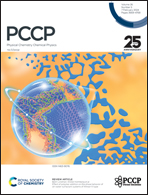First-principles study of magnetic properties and electronic structure of 3d transition-metal atom–adsorbed SnSSe monolayers†
Abstract
We investigated the electronic structure and magnetic characteristics of 3d transition metal elements (Sc, Ti, V, Cr, Mn, Fe, Co, Ni, Cu, and Zn) adsorbed onto monolayer SnSSe by employing first-principles calculations. After the calculation, we found that Sc, Ti, V, Cu, and Zn atoms adsorbed onto monolayer SnSSe do not have magnetic moments, while the rest of the atoms adsorbed onto SnSSe are able to produce magnetic moments, and their magnetic moments in the adsorption systems are in the range of 1.0–3.0 μB, in which the magnetic distance of Mn is the largest. The results of MAE calculations indicate that there is a big difference in the MAE of the systems with TM atoms adsorbed to the S-side and the Se-side; for V adsorbed to the S-side on the Sn atoms, the MAE is the largest, which reaches 8.277 meV f.u.−1, showing an in-plane magnetic anisotropy, and for Co adsorbed to the Se-side on the Sn atoms, the MAE is the smallest, which is −0.673 meV f.u.−1, showing a perpendicular magnetic anisotropy. Calculations of binding energies show that all atoms are able to adsorb stably. Our results indicate the potential application of TM-adsorbed SnSSe monolayers in spintronics and magnetic memory devices.



 Please wait while we load your content...
Please wait while we load your content...